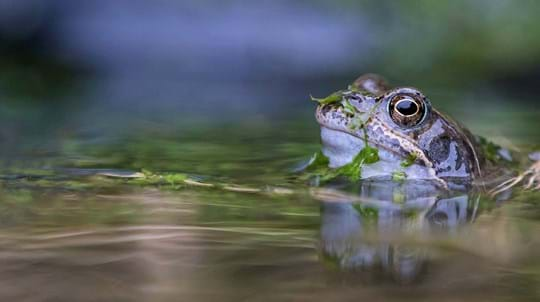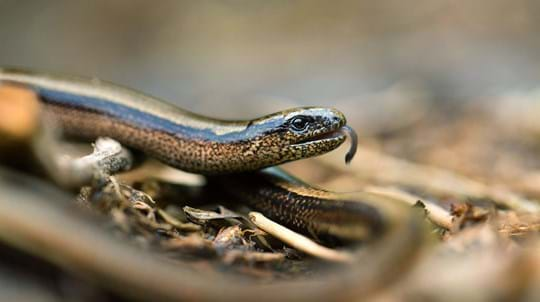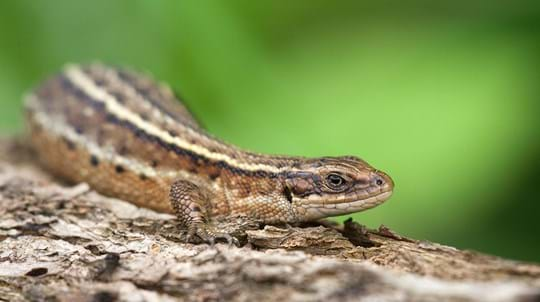
Credit: Damian Waters / Alamy Stock Photo
Mating
Males vie for the attention of a female by fighting competing males. If she’s impressed, the male will jump on her back and use special ‘nuptial pads’, known as 'amplexus', to grasp her.
Lover of damp log piles and deep leaf litter. The common toad spends much of its year in moist, shaded places, often in woodland, feeding on worms, slugs and insects. When it’s scared or threatened, the warts on its back secrete a vile-tasting substance – its defence against predators.
Common name: Common toad, European toad
Scientific name: Bufo bufo
Family: Bufonidae (toads)
Habitat: woodland, grassland and gardens as adults. Ponds as tadpoles.
Diet: Invertebrates, smaller amphibians, even small mammals
Predators: carnivorous mammals like otters and hedgehogs, grass snakes, herons, birds of prey.
Origin: native
The common toad can vary in colour from olive brown to green, dark brown or grey, sometimes with dark markings. Its skin is characteristically dry and ‘warty’. It has copper-coloured eyes with a horizontal pupil. It can grow up to 13cm in length and females are larger than males.
Not to be confused with: the common frog. Toads tend to be larger as well as having shorter legs than the common frog. The toad also walks or crawls whereas frogs hop. Toadspawn is laid in long strings, whereas frogspawn is laid in large clumps. After hatching, toad tadpoles are black while frog tadpoles are greener.
Toads are active at night, when they hunt for a variety of invertebrates including slugs, spiders, worms, aphids and ants. They sneak up on prey and use their sticky tongues to catch it.
Some larger toads may eat harvest mice, slow worms, small grass snakes and even younger toads.
Tadpoles eat algae and plant matter.
While the average female common toad will produce 1,500 eggs, as many as 5,000 have been recorded from one female.
During the breeding season in early spring, toads migrate to the pond in which they were spawned, to find a mate and reproduce. Male toads arrive first and wait for females at these ponds, although some choose to ambush the females on the way, jumping on their backs mid-journey.

Credit: Damian Waters / Alamy Stock Photo
Males vie for the attention of a female by fighting competing males. If she’s impressed, the male will jump on her back and use special ‘nuptial pads’, known as 'amplexus', to grasp her.

Credit: Doug Mccutcheon / Alamy Stock Photo
When spawning, the female releases double strings of fertilised eggs among waterweeds. One female will produce around 1,500 eggs. After 10 days, the tadpoles emerge.

Credit: DP Wildlife Vertebrates / Alamy Stock Photo
Tadpoles mature in around 16 weeks, gradually losing their tails and growing legs as they develop into toadlets. They usually leave their spawning pond in May.
During the winter, the common toad overwinters rather than hibernates. It spends much of its time burrowed in mud or compost conserving energy, but will emerge to forage in milder spells.

Credit: Naturepix / Alamy Stock Photo
Common toads are found throughout mainland Britain but not in Ireland.
For most of the year, toads live in gardens, rough grassland, hedgerows and woodland, away from water.
The common toad has foul tasting skin to put predators off eating them. They also puff up when threatened.
Common toads are nocturnal and best spotted at night. They live in shallow burrows and conserve energy during the day. During the spring and mating season, toads will migrate to the pond they were spawned in to mate and spawn. You may see them on their way!
Listen out for their low croaking near ponds in wet woodland.
Like many of the UK’s native species, the common toad has been impacted by loss of habitat, particularly the loss of breeding ponds. Drainage of wet areas has reduced the amount of wet woodland, and human infrastructure like roads pose a serious threat by disrupting migration routes. An increasing number of toads are also killed by traffic during the spring as they attempt to travel to their breeding ponds.
By buffering areas of wet woodland with newly planted trees, we are working to protect this vital habitat. You can also support the common toad by leaving part of your garden to grow wild, giving toads somewhere safe to overwinter.

Trees woods and wildlife
Smooth. Slick. Slippery. These quick-jumping masters of disguise are regular visitors to garden ponds. Learn some interesting facts about them.

Trees woods and wildlife
Discover the slow worm, a legless lizard which resembles a snake. Find out what it eats, where it lives and how it breeds.

Trees woods and wildlife
The common lizard is a speedy little fella, often seen basking in the sun. Find out how to spot it, what it eats and how it breeds.